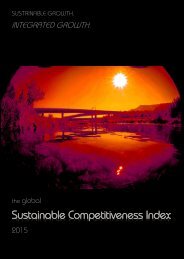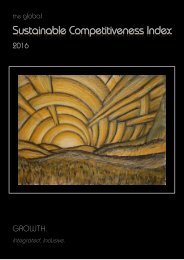Sustainable_Competitiveness_Index_2013
Create successful ePaper yourself
Turn your PDF publications into a flip-book with our unique Google optimized e-Paper software.
The Global <strong>Competitiveness</strong> Report<br />
WEF Methodology<br />
The Davos Man Global <strong>Competitiveness</strong> Report: 3 main criteria, 12 pillars<br />
The WEF (in the Global <strong>Competitiveness</strong> Report) defines competitiveness “as the set of institutions,<br />
policies, and factors that determine the level of productivity of a country”. It is further argues that<br />
the level of productivity sets the level of prosperity that can be earned by an economy, as well as<br />
the rates of return obtained by investments in an economy. Productivity and returns of investments<br />
of an economy are considered “the fundamental drivers of its growth rates”, leading to “a more<br />
competitive economy which is likely to sustain growth.” Based on this definition, the WEF definest 3<br />
main criteria, subdivided in 12 pillars of competitiveness, representing a total of 115 indicators. The<br />
three main criteria are “basic requirements” (institutions and infrastructure), “efficiency enhancers”<br />
(education levels, market mechanism and size, labor flexibility, financial market liberalization,<br />
technology adaption), and “innovation and sophistication (market maturity, R&D). The indicators<br />
are described in detail on the next page.<br />
The index is computed based on indicator performance. The indicators within a category seem to<br />
be equally weighted, as are categories within a pillar. However, the weightings of the 3 main<br />
criteria differs depending on the level of development of a country (defined as GDP per capita).<br />
The weightings of the “basic requirements” indicators is higher for a poor countries (“factor-driven<br />
economies” according to the WEF terminology), and decreasing over 5 stages of development<br />
(GDP per capita) to mature "innovation-driven” economies. The weightings for the last criteria,<br />
“Innovation and sophistication”, is highest for the richest countries.<br />
The <strong>Sustainable</strong> <strong>Competitiveness</strong> <strong>Index</strong> does not weight indicators or pillar according to the level<br />
of income of a country, but computes each indicator weighting according to its relevance in<br />
achieving and sustaining sustainable wealth e.<br />
Composition of the WEF’s <strong>Competitiveness</strong> <strong>Index</strong><br />
50<br />
The <strong>Sustainable</strong> <strong>Competitiveness</strong> <strong>Index</strong> <strong>2013</strong><br />
Table of contents








